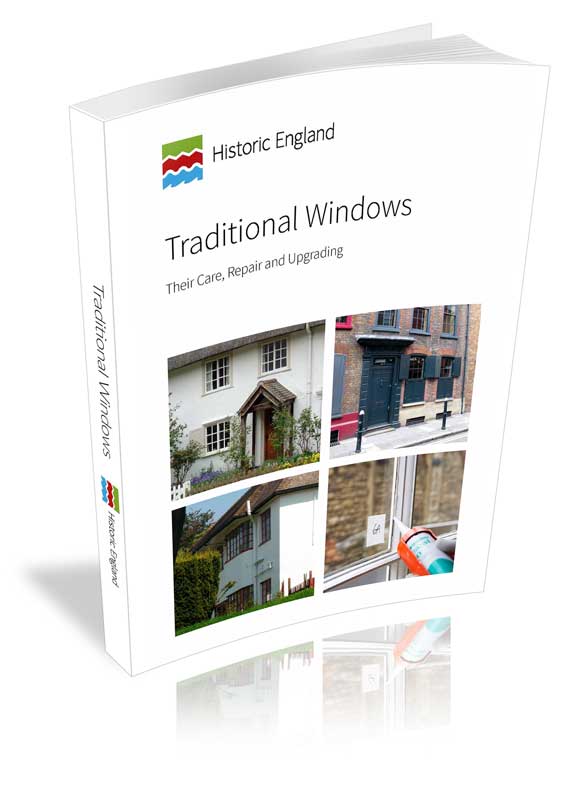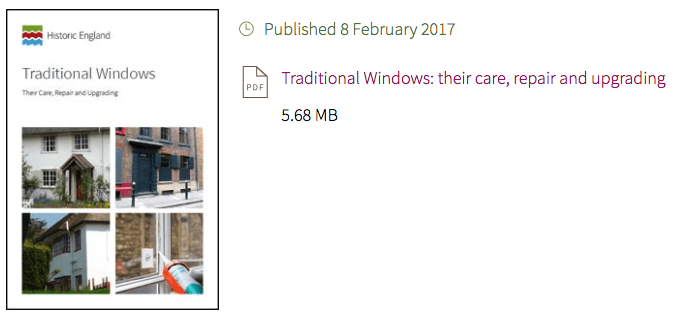Traditional Windows – The Definitive Report by English Heritage
The “Traditional Windows” report is a comprehensive document covering all aspects of historical windows. It was written and compiled by David Pickles, Iain McCaig and Chris Wood with assistance from Nick Molyneux and Eleni Makri in 2014.
The aim of this report is to raise awareness of the need to preserve older windows as part of the heritage of the UK. The report deplores the use of uPVC windows in historic buildings
“Replacement plastic (PVC-u) windows pose one the greatest threats to the heritage value of historic areas”.
The report also advocates the repair rather than replacement of these windows and gives a deal of information on the restoration and repair of older windows. Where repair in not possible, the report gives details of how to go about replacing them including where to get accurate advice and the proper consents.
Who are Historic England?
Historic England is a public body that “helps people care for, enjoy and celebrate England’s spectacular historic environment.” The purpose of the organisation is to look after the “history that surrounds us all” in the UK. They do this by:
- Championing historic places
- Identifying and protecting our heritage
- Supporting change
- Understanding historic places and
- Providing expertise at a local level
You can find out more about Historic England on their website www.historicengland.co.uk.
What is in the Traditional Windows Report?
The report is comprehensive and could be considered a go-to document for anyone looking for information and advice on the history of windows in the UK, care and maintenance of historic windows and the reasons why we should preserve them.
Introduction – why traditional windows should be preserved
The introduction of the report goes into how we are losing so many historic windows, and why we should work to preserve the ones we have left.
The use of plastic windows in obviously abhorrent to the values of Historic England, as is also the modern day culture of replacing anything that is either slightly worn out or just unfashionable:
“the idea that old windows are ‘worn out’ is driven largely by a culture of replacement and fashion rather than by an actual assessment of their condition and performance”.
The report defines how a window is deemed worthy of preservation in and aside titled ‘Determining Significance’.
Section 1 – A brief history of windows
Despite the title of this section, there is a wealth of information here about traditional windows. It covers in great detail the history of windows design and manufacture from medieval times to the present day.
Window Frames
The history of windows frames is covered first. The relationship between glass manufacture and window frames is shown to affect the architecture of the day. We are taken on a journey through the evolution of building design and the effect the windows have on the buildings.
We are shown many examples of the progression of window frame design and technology with reference to how the development of more sophisticated materials altered the fashions of the day.
We are given the history of the materials used in window frame manufacture. As the industry mastered the production of certain materials, so we see how fashions change and we are shown illustrations of how windows work in cutaway diagrams.
We also find out about the colours people used to paint their windows and how fashions changed over time and how colour was also a status symbol (gold leaf window frames, really?)
Glass manufacturing
The relationship between window frame design and the ability to manufacture glass is fascinating. We are shown how as glass manufacturing improved with bigger and stronger panes, so building design evolved alongside.
Shutters (which actually predate glass windows) and ironmongery are also covered in this section.
Section 2 – Maintaining Windows
The next section of the report is all about maintaining traditional windows. Covering timber and metal windows, we are told how to identify problems and how to rectify them. There is a guide on how to overhaul and decorate both types of windows with plenty of step-by-step illustrations. The chapter on painting and preparation should be read by anybody who owns a paintbrush and a tin of gloss paint (alternative title for this chapter: “How I do it wrong every time”). It’s worth mentioning that modern timber windows utilise water-based paint systems and the approach to maintenance will be much different.
Section 3 – Repairing Windows
The report is careful to identify the differences between maintenance and repair:
“The purpose of repair is to replace or reinforce those parts of the window that have decayed so badly that they can no longer function as intended.”
Because the emphasis is on historical accuracy, attention is drawn to the importance of recording the existing windows prior to commencing any repairs. It is the reports’ goal to preserve as much as possible the traditional aspect of much of English architecture. That is the reason why the report goes into so much detail about how to maintain and repair original items rather simply replacing them.
Again, both timber and metal framed windows are covered in some depth with more helpful step by step guides and illustrations. Repairing glass is also covered, as is what should be fixed – repairs can also be of historical importance:
“As a general rule, historic glass should not be rearranged, nor should later additions and repairs to the glazing be removed as these too can contribute to the significance of the window, unless there is a strong conservation argument for doing so.”
Section 4 – Thermal Upgrading
Historic England completely recognises the need of homeowners to improve the thermal efficiency of their windows.
We are given details on the extensive research the organisation has put into how maintaining older windows can dramatically improve their performance.
Improving the thermal efficiency of older windows
The organisation in its effort to preserve historic windows recommends:
- Mend cracks and eliminate gaps – up to 33% improvement
- Draught proofing – up to 86% improvement
- Install thermal roller blinds – 57% cut in heat loss
- Fit secondary glazing – 60% reduction in heat loss
- Shutters or curtains – 41% reduction in heat loss
We are not told exactly what difference the improvement make as an alternative to a modern replacement, only that:
“The heat transfer through the frame greatly limited the improvement that could be gained by replacing single glass with slim-profile double glazing.”
We can only conclude that replacing historic windows with modern double glazing is the best option from a thermal efficiency perspective, but there are many arguments against doing this.
Again, we are given guides on all the aspects of improving the thermal efficiency of older windows with the expected high-quality illustrations and photographic step by step guides to accompany the text.
Double Glazing and Historic Windows
Interestingly, there is a section on adding double glazing to the original frames and the circumstances in which this is appropriate. It is also worth noting that secondary glazing is in some cases more efficient than double glazing as it’s the frames that allow much of the heat to transfer. This must be of particular importance in older windows constructed of many smaller panes held together by frames (or window bars as they should be called).
Section 5 – Replacing Windows
This section sets out what to do if a window is really beyond repair, or if you are seeking to restore a traditional window in an opening that has had an inappropriate window inserted at a later date.
We are told immediately that “Replacing an historic window in a listed building will require listed building consent from the local planning authority.” and the next section goes into this in greater detail.
The fact that this is one of the shortest sections in the report shows that Historic England favours repair over replacement.
Section 6 – Consents
This section covers how to get the appropriate permissions to repair or replace historic windows. Where and how to obtain permission, and how Building Regulations affects the work involved – sometimes the regulations must reconcile thermal performance and building conservation.
When consent is required
The section clearly informs the reader on which building need permission to make improvements and how these improvements are legally documented in the Historic England publication Energy Efficiency and Historic Buildings: application of Part L of the Building Regulations to historic and traditionally constructed buildings. Read It Here.
Section 7 – Where to Get Advice
This section is a directory of helpful sources covering:
- Amenity Societies
- Trade Organisations
- Specialist Help
- Further Reading
- Thermal Upgrading
Section 8 – Acknowledgements
The report ends with a list of acknowledgements and where to contact Historic England.
Traditional Windows Report – In Conclusion
In summary, this report should be the go-to guide for anyone with historic buildings or involved with the renovation of Listed Buildings. The history of windows is fascinating, especially to someone who’s windows may be covered in the report. The how to guides are excellent and should help both DIY enthusiasts and professionals alike.
The main thrust of the report is to emphasise the why. It is not difficult to get on board with Historic England’s ethos of preservation of the historic buildings around us. However, it would be nice to see the report updated to include more information about vacuum glazing and heritage windows and perhaps a trade directory of manufacturers and repair service providers with the skills to support the mandate put forward by the report to retain authenticity but not necessarily at the expense of efficiency.

Read more about Heritage Windows in our comprehensive Guide to Replacing Windows in Listed Buildings

